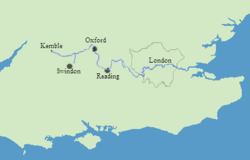River Thames to receive clean-up with new tunnel
Friday, March 23, 2007

At an event at Abbey Mills pumping station in Stratford, East London on March 22, 2007, UK Environment Minister Ian Pearson announced an ambitious project to clean up the River Thames in London.
A tunnel, 30 kilometres in length, will be built alongside the river to intercept sewage and stormwater runoff that flows into the Thames currently. The tunnel would shunt the wastewater to a treatment facility in East London. Some 52 million cubic metres of wastewater streams into the Thames each year.

According to a Parliamentary Statement released March 22, the discharges kill fish, create a higher health hazard for users of the river and reduce the aesthetic appeal of the Thames.
“London today is more densely populated, and the greater urbanisation – such as the increase in paved areas – has led to more and faster rainwater run-off and, unfortunately, to an increase in storm overflows into the river," said David Owens, Thames Water’s Chief Executive Officer in a press release.
“London’s sewers are one of the great engineering wonders of the Victorian age and have served the capital well for more than 150 years," continued Owens.
The tunnel is projected to cost a minimum £2 billion and would be considered the largest such project undertaken in Great Britain.
The announcement comes after six years of detailed study. Experts such as the Thames Tideway Strategic Study, consultants Jacobs Babtie, and Thames Water played a significant role in determining a solution. All recommended a tunnel under the Thames as the right approach to the problem.
"We haven't reached this decision in a vacuum," said Pearson. "A wide range of players have been instrumental in getting us to this point and I thank them all." Further work on the project, such as detailed design, planning and funding, will now follow.
| I think most Londoners would be shocked to hear that...a huge amount of untreated sewage and rainwater is spilling into the Thames | ||
—Ian Pearson | ||
Funding the project, admits Pearson, may put a strain on ratepayers. "This will inevitably mean some extra costs for customers, but it will deliver tangible benefits for London in the long-term," said Pearson. It is estimated that it will add around £37 to Thames Water sewerage bills by 2017.
There has been criticism of projected expenses. "The costs will be met wholly through increases in consumers' bills," said David Bland, chairman of Consumer Council for Water Thames, in a BBC interview. He suggested the fees "will be far more than most are willing or expecting to pay."
Proceeding with the tunnel would not only improve the environmental quality of the Thames, suggests the government, it would also help satisfy European obligations on sewage treatment.
The project is expected to be completed by 2019/20.
Sources
- News Release. "New tunnel to give London a cleaner River Thames" — Defra, March 22, 2007
- "New tunnel for Thames pollution" — BBC News, March 22, 2007
- Press Release. "Thames Water Welcomes Tideway Tunnel Decision" — Thames Water, March 22, 2007
| This page has been automatically archived by a robot, and is no longer publicly editable.
Got a correction? Add the template {{editprotected}} to the talk page along with your corrections, and it will be brought to the attention of the administrators. Please note that the listed sources may no longer be available online. |